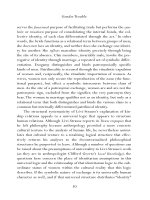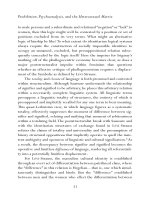GENDER TROUBLE 9
Bạn đang xem bản rút gọn của tài liệu. Xem và tải ngay bản đầy đủ của tài liệu tại đây (20.33 KB, 1 trang )
Gender Trouble
that restricts the meaning of gender in the presuppositions of its own
practice sets up exclusionary gender norms within feminism, often
with homophobic consequences. It seemed to me, and continues to
seem, that feminism ought to be careful not to idealize certain expressions of gender that, in turn, produce new forms of hierarchy and
exclusion. In particular, I opposed those regimes of truth that stipulated that certain kinds of gendered expressions were found to be false or
derivative, and others, true and original. The point was not to prescribe a new gendered way of life that might then serve as a model for
readers of the text. Rather, the aim of the text was to open up the field
of possibility for gender without dictating which kinds of possibilities
ought to be realized. One might wonder what use “opening up possibilities” finally is, but no one who has understood what it is to live in
the social world as what is “impossible,” illegible, unrealizable, unreal,
and illegitimate is likely to pose that question.
Gender Trouble sought to uncover the ways in which the very thinking of what is possible in gendered life is foreclosed by certain habitual
and violent presumptions. The text also sought to undermine any and
all efforts to wield a discourse of truth to delegitimate minority gendered and sexual practices. This doesn’t mean that all minority practices are to be condoned or celebrated, but it does mean that we ought
to be able to think them before we come to any kinds of conclusions
about them.What worried me most were the ways that the panic in the
face of such practices rendered them unthinkable. Is the breakdown of
gender binaries, for instance, so monstrous, so frightening, that it must
be held to be definitionally impossible and heuristically precluded
from any effort to think gender?
Some of these kinds of presumptions were found in what was
called “French Feminism” at the time, and they enjoyed great popularity among literary scholars and some social theorists.
Even as I opposed what I took to be the heterosexism at the core of
sexual difference fundamentalism, I also drew from French poststructuralism to make my points. My work in Gender Trouble turned out to be
viii









